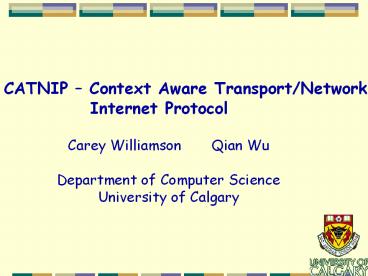CATNIP PowerPoint PPT Presentation
1 / 24
Title: CATNIP
1
CATNIP Context Aware Transport/Network
Internet Protocol
Carey Williamson Qian Wu Department of
Computer Science University of Calgary
2
Why CATNIP
- Layered protocol stacks
3
Why CATNIP (Contd)
- Observations in Web data transfer using TCP/IP
- Poor protocol interactions
- TCPs window-based flow control mechanism
produces data bursts - Not all packet losses are created equal. Packet
losses are costly for small document transfer - A TCP source has limited control over packet loss
effects - An IP router has significant control over packet
loss effects.
4
(No Transcript)
5
Design of CATNIP
- Can we make the TCP/IP protocols smarter about
the specific job? - Convey application-layer context information to
the TCP and IP layers
Application
Transport
Network
6
Design of CATNIP (Contd)
- Adding context-awareness to TCP
- Rate-Based Pacing of the Last Window (RBPLW)
- Early Congestion Avoidance (ECA)
- Selective Packet Marking (SPM)
- Use the reserved high-order bit in the TCP
header to convey packet priority information
7
(No Transcript)
8
Design of CATNIP (Contd)
- Adding context-awareness to IP
- CATNIP-Good
- CATNIP-Bad
- CATNIP-RED RED CATNIP-Good
9
Evaluation of CATNIP
Simulation ns-2
Evaluation
Emulation use WAN emulation to test a prototype
implementation of CATNIP in the Linux kernel of
an Apache Web server.
10
- Evaluation using simulation
- Network model
Client 1
Server 1
10 Mbps, 5 ms
10 Mbps, 5 ms
Client 2
1.5 Mbps, 5 ms
Server 2
RouterS
RouterC
Client 99
10 Mbps, 5 ms
10 Mbps, 5 ms
Client 100
Server 10
11
- Evaluation using simulation (Contd)
- Web workload model
- 10 Web pages
- Use empirically-observed distribution to
determine the size, and the number of embedded
images
12
- Evaluation using simulation (Contd)
- Factors and Levels
- Performance metrics
- the transfer time for each Web page
- the average packet loss
13
- Simulation results
- DropTail routers
- Mean and standard deviation of transfer times
14
- Packet loss
- Observations
- TCP endpoint control algorithms have little
advantage to offer.
15
- Simulation results (Contd)
- CATNIP-Good routers
- Mean and standard deviation of transfer times
16
- Packet loss
- Observations
- Adding context-awareness at the IP routers
improves the mean Web page transfer times and the
standard deviation of the transfer times. - The average packet loss rates with CATNIP-Good
are higher than for the DropTail routers.
17
- Simulation results (Contd)
- CATNIP-Bad routers
- Mean and standard deviation of transfer times
18
- Packet loss
- Observations
- Packet losses are shifted to the high priority
TCP packets, that is, throw away the wrong
packet at the wrong time, therefor makes
matters worse.
19
- Simulation results (Contd)
- CATNIP-RED routers
- Mean and standard deviation of transfer times
20
- Observations
- Reno and ECA perform similarly in almost all
cases. - The effect of CATNIP-RED is greater than the
effect of ECA.
21
- Experimental Implementation and Evaluation
- Experimental environment
- WAN emulator IP-TNE (Internet Protocol Traffic
and Network Emulator) - Web server
- Apache Web server (version 1.3.19-5) runs on top
of modified Linux 2.4.16 kernel. - Implementation focused on the SPM feature only
22
- Network model
Client 1
10 Mbps, 5 ms
Client 2
10 Mbps, 5 ms
1.5 Mbps, 5 ms
RouterS
RouterC
Endpoint
Server
Client 99
10 Mbps, 5 ms
Client 100
WAN Emulation
- Primary Factor
- buffer size of the bottleneck link (64 KB --
512 KB)
23
- Evaluation results
24
- Conclusions
- Not all packet losses are created equal
- A TCP source alone has limited control over Web
data transfer performance, even with
application-layer information - The IP layer has a significant influence on Web
data transfer performance, particularly when
application-layer context information is
available - A simple change to the TCP/IP stack
implementation can provide the context
information - Changes to the queue management at routers can
provide significant performance advantages for
the context-aware TCP/IP.
25
Questions?

